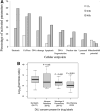A testing strategy to predict risk for drug-induced liver injury in humans using high-content screen assays and the 'rule-of-two' model
- PMID: 24958025
- PMCID: PMC5753582
- DOI: 10.1007/s00204-014-1276-9
A testing strategy to predict risk for drug-induced liver injury in humans using high-content screen assays and the 'rule-of-two' model
Abstract
Drug-induced liver injury (DILI) is a major cause of drug failures in both the preclinical and clinical phase. Consequently, improving prediction of DILI at an early stage of drug discovery will reduce the potential failures in the subsequent drug development program. In this regard, high-content screening (HCS) assays are considered as a promising strategy for the study of DILI; however, the predictive performance of HCS assays is frequently insufficient. In the present study, a new testing strategy was developed to improve DILI prediction by employing in vitro assays that was combined with the RO2 model (i.e., 'rule-of-two' defined by daily dose ≥100 mg/day & logP ≥3). The RO2 model was derived from the observation that high daily doses and lipophilicity of an oral medication were associated with significant DILI risk in humans. In the developed testing strategy, the RO2 model was used for the rational selection of candidates for HCS assays, and only the negatives predicted by the RO2 model were further investigated by HCS. Subsequently, the effects of drug treatment on cell loss, nuclear size, DNA damage/fragmentation, apoptosis, lysosomal mass, mitochondrial membrane potential, and steatosis were studied in cultures of primary rat hepatocytes. Using a set of 70 drugs with clear evidence of clinically relevant DILI, the testing strategy improved the accuracies by 10 % and reduced the number of drugs requiring experimental assessment by approximately 20 %, as compared to the HCS assay alone. Moreover, the testing strategy was further validated by including published data (Cosgrove et al. in Toxicol Appl Pharmacol 237:317-330, 2009) on drug-cytokine-induced hepatotoxicity, which improved the accuracies by 7 %. Taken collectively, the proposed testing strategy can significantly improve the prediction of in vitro assays for detecting DILI liability in an early drug discovery phase.
Figures



References
-
- Andersen ME, Krewski D. Toxicity testing in the 21st century: bringing the vision to life. Toxicol Sci. 2009;107:324–330. - PubMed
-
- Bleicher KH, Bohm HJ, Muller K, Alanine AI. Hit and lead generation: beyond high-throughput screening. Nat Rev Drug Discov. 2003;2:369–378. - PubMed
-
- Chen M, Vijay V, Shi Q, Liu Z, Fang H, Tong W. FDA-approved drug labeling for the study of drug-induced liver injury. Drug Discov Today. 2011;16:697–703. - PubMed
-
- Chen M, Zhang M, Borlak J, Tong W. A decade of toxicogenomic research and its contribution to toxicological science. Toxicol Sci. 2012;130:217–228. - PubMed
-
- Chen M, Borlak J, Tong W. High lipophilicity and high daily dose of oral medications are associated with significant risk for drug-induced liver injury. Hepatology. 2013a;58:388–396. - PubMed
Publication types
MeSH terms
Substances
Grants and funding
LinkOut - more resources
Full Text Sources
Other Literature Sources
Medical

